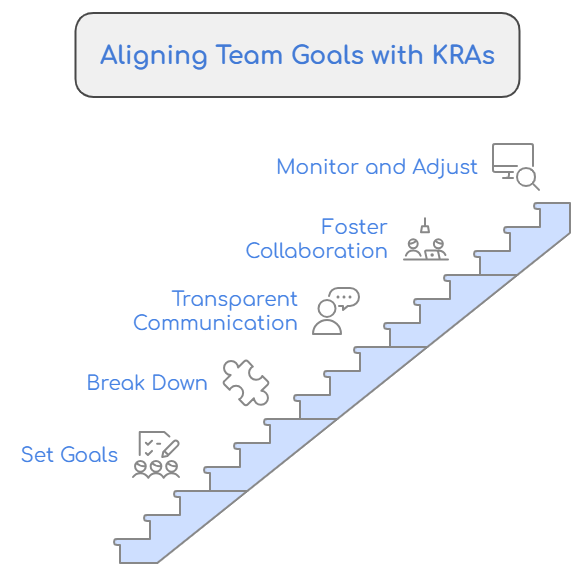Aligning team goals with Key Responsibility Areas (KRAs) is important for driving organizational success. When there is a clear connection between what your team is working towards and each individual’s responsibilities, productivity skyrockets, and so does job satisfaction. Proper alignment ensures that every member knows how their role contributes to the bigger picture, creating a flow of effort and collaboration.
Here’s a deep understanding into how to ensure team goals are aligned with KRAs and drive exceptional results.
Why Aligning Team Goals with KRAs Matters
A team that understands how their responsibilities tie into larger company objectives is more likely to remain engaged and motivated. When employees see how their daily tasks impact the company’s success, they are more driven to perform better. On the other hand, misalignment can lead to confusion, decreased productivity, and frustration.
Boosted Productivity and Efficiency
By aligning team goals with KRAs, you are creating a roadmap for success. Every team member knows where they are headed and what is expected of them, minimizing time spent on non-productive tasks. This clarity leads to streamlined operations and fewer misunderstandings, allowing everyone to focus on high-priority items.
Enhanced Accountability
Defining each team member’s role and linking it to broader goals also fosters accountability. When Key Responsibility Areas (KRAs) are clearly outlined, it becomes easier to assess individual performance. If team members know exactly what they’re responsible for, they can hold themselves accountable, and management can track progress with precision.
Steps to Align Team Goals with KRAs

1. Set Clear and SMART Team Goals
The first step to alignment is to establish clear, specific, and achievable team goals. SMART (Specific, Measurable, Achievable, Relevant, Time-bound) goals ensure that there is no vagueness in what needs to be accomplished. Each goal should be clearly communicated and discussed among the team to ensure collective buy-in.
2. Break Down Goals into Individual KRAs
Once the team goals are set, the next step is to break them down into specific Key Responsibility Areas (KRAs) for each team member. KRAs should be directly linked to the team’s objectives, so that each person understands how their role contributes to the overarching goal.
3. Ensure Transparent Communication
Maintaining open communication channels is important for ensuring alignment. Regularly discuss how the team’s progress is tracking against the set goals and encourage team members to provide updates on their KRAs. Open dialogue prevents any misalignment between individual efforts and team objectives.
Regular meetings, performance reviews, and feedback sessions are invaluable tools in keeping everyone on the same page.
4. Foster Collaboration Across Departments
In larger organizations, multiple teams often work toward the same or complementary goals. It is important to promote cross-departmental collaboration to make sure alignment is not only within teams but across the organization too.
5. Regularly Monitor and Adjust KRAs
Team goals and KRAs shouldn’t be static. As the business landscape shifts, so too must your team’s objectives and responsibilities. Regularly reviewing and adjusting KRAs ensures that the team remains agile and responsive to any changes.
Challenges to Aligning KRAs with Team Goals
While aligning KRAs with team goals offers substantial benefits, there are a few common challenges that organizations may face. Identifying and addressing these challenges early on ensures a smoother alignment process.
Lack of Clarity in Goals
When team goals are not well-defined or are too broad, it becomes difficult to link them effectively to individual KRAs. It’s important to invest time in refining goals before breaking them down into responsibilities.
Resistance to Accountability
Not all employees may feel comfortable with the idea of being held accountable for specific KRAs. Resistance often stems from fear of failure or unclear expectations. Overcoming this challenge involves fostering a supportive environment where accountability is seen as a pathway to growth.
Inconsistent Communication
Failure to maintain open and regular communication can result in confusion and misalignment. Ensuring that updates, changes, and progress are shared consistently across the team is vital for staying on track.
Best Practices for Sustaining Alignment Over Time
To maintain alignment between team goals and KRAs, follow these best practices:
1. Encourage Continuous Feedback
Fostering an environment where feedback is regularly exchanged ensures that everyone stays informed of changes and progress. Team members should feel comfortable discussing challenges with their KRAs and seeking guidance when necessary.
2. Provide Ongoing Training and Development
Continual professional development opportunities equip team members with the skills they need to meet evolving KRAs and goals. Investing in training keeps the team adaptable and prepared for future challenges.
3. Recognize and Reward Performance
Celebrate when team members successfully achieve their Key Responsibility Areas (KRAs) or make meaningful contributions toward the team’s goals. Recognition and rewards can be powerful motivators, reinforcing the importance of staying aligned with objectives.
4. Use Technology for Tracking and Reporting
Implementing software that tracks individual progress against KRAs can simplify monitoring. Tools such as project management systems allow for real-time updates and visibility into how well team goals are being met, ensuring that no one falls behind.
Conclusion
Aligning team goals with Key Responsibility Areas (KRAs) is important for driving operational efficiency and achieving business objectives. By following a structured approach—setting SMART goals, breaking them down into individual KRAs, and ensuring consistent communication—you can create a high-performing team that remains focused and accountable. Regularly reviewing and adjusting KRAs to keep up with changing conditions ensures that your team stays on track to success.
359 views






